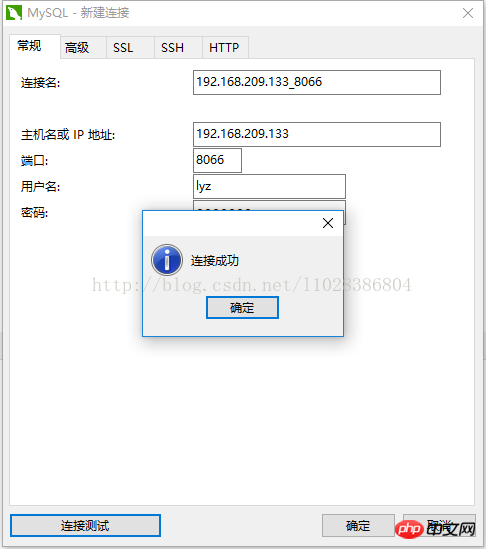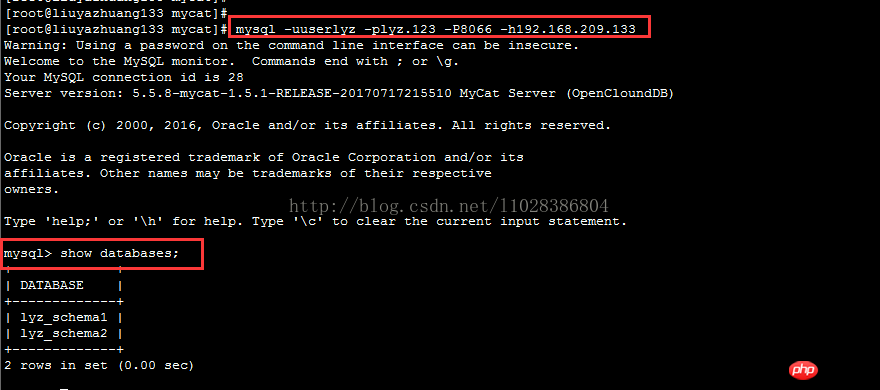Home >Database >Mysql Tutorial >Example of Mycat read-write separation based on MySQL master-slave replication
Today, I bring you an article about Mycat achieving read-write separation based on MySQL master-slave replication. What you need to note here is that MySQL’s master-slave replication relies on MySQL’s own master-slave replication mechanism, and Mycat is not responsible. MySQL's master-slave replication. For information about MySQL's master-slave replication configuration, you can refer to the blog post "MySQL - Master-Slave Replication Configuration". Okay, let's get into today's topic.
Operating system: CentOS-6.5-x86_64-bin-DVD1.iso
JDK version: jdk1.7.0_80
MyCat version: Mycat- server-1.5.1-RELEASE-20170717215510-linux.tar.gz (Download the source code and compile it yourself)
MyCat node IP: 192.168.209.133 Host name: liuyazhuang133 Host configuration: 4-core CPU, 4G memory
MySQL version :mysql-5.6.32.tar.gz
Master node IP: 192.168.209.131 Host name: liuyazhuang131 Host configuration: 4-core CPU, 4G memory
Slave node IP: 192.168.209.132 Host name: liuyazhuang132 Host configuration: 4-core CPU, 4G memory
MyCat’s read-write separation is based on the back-end MySQL cluster It is implemented through master-slave synchronization, and MyCat provides statement distribution function. MyCat 1.4 begins to support the read-write separation mechanism of MySQL master-slave replication state binding, making reading more secure and reliable.

# vi /etc/sysconfig/network NETWORKING=yes HOSTNAME=liuyazhuang133
# vi /etc/hosts 127.0.0.1 liuyazhuang133 192.168.209.131 liuyazhuang131 192.168.209.132 liuyazhuang132 192.168.209.133 liuyazhuang133
Because MyCat is developed in Java, JDK needs to be installed to run MyCat (JRE is enough to be precise), and JDK1.7 or above is required
# vi /etc/profile ## java env export JAVA_HOME=/usr/local/java/jdk1.7.0_80 export JRE_HOME=$JAVA_HOME/jre export CLASSPATH=.:$JAVA_HOME/lib/dt.jar:$JAVA_HOME/lib/tools.jar:$JRE_HOME/lib/rt.jar export PATH=$PATH:$JAVA_HOME/bin:$JRE_HOME/bin # source /etc/profile # java -version
Upload Mycat-server-1.5.1-RELEASE-20170717215510-linux.tar.gz to the /home/mycat directory in the MyCat server, unzip and Move to the /usr/local/mycat directory
$ tar -zxvf Mycat-server-1.5.1-RELEASE-20170717215510-linux.tar.gz
# mv /home/mycat/mycat /usr/local/ # cd /usr/local/mycat/ # ll

# vi /etc/profile ## mycat env export MYCAT_HOME=/usr/local/mycat export PATH=$PATH:$MYCAT_HOME/bin # source /etc/profile
Supplement:
(1) In the MySQL master-slave replication configuration, if it involves synchronous replication of functions or stored procedures, you need to add the configuration log_bin_trust_function_creators=true or in the [mysqld] section in /etc/my.cnf Set set global log_bin_trust_function_creators = 1 in the client;
(2) If you want to do a master-slave switch under read-write separation, the slave node may also become a write node, so the slave node cannot be set to read_only. =1.
(3) The Linux version of MySQL needs to be set to MySQL case insensitivity, otherwise the problem of table not being found may occur. You can add lower_case_table_names=1 in the [mysqld] section of /etc/my.cnf.
[root@liuyazhuang133 conf]$ cd /usr/local/root/conf/ [root@liuyazhuang133 conf]$ vi schema.xml
<?xml version="1.0"?>
<!DOCTYPE mycat:schema SYSTEM "schema.dtd">
<mycat:schema xmlns:mycat="http://org.opencloudb/">
<!-- 定义MyCat的逻辑库,逻辑库的概念与MySQL中的 database 概念相同 -->
<!-- schema name="rc_schema1" checkSQLschema="false" sqlMaxLimit="100" dataNode="rc_dn1"></schema -->
<!--schema name="pay_schema1" checkSQLschema="false" sqlMaxLimit="100" dataNode="pay_dn1"></schema-->
<schema name="lyz_schema1" checkSQLschema="false" sqlMaxLimit="100" dataNode="lyz_dn1"></schema>
<schema name="lyz_schema2" checkSQLschema="false" sqlMaxLimit="100" dataNode="lyz_dn2"></schema>
<!-- 其中checkSQLschema表明是否检查并过滤SQL中包含schema的情况,如逻辑库为 TESTDB,则可能写为select * from TESTDB.edu_user,此时会自动过滤TESTDB,SQL变为select * from edu_user,若不会出现上述写法,则可以关闭属性为false -->
<!--sqlMaxLimit默认返回的最大记录数限制,MyCat1.4版本里面,用户的Limit参数会覆盖掉MyCat的sqlMaxLimit默认设置-->
<!-- 定义MyCat的数据节点 -->
<dataNode name="lyz_dn1" dataHost="dtHost2" database="lyzdb1" />
<dataNode name="lyz_dn2" dataHost="dtHost2" database="lyzdb2" />
<!-- dataNode 中的 name 数据表示节点名称, dataHost表示数据主机名称, database表示该节点要路由的数据库的名称 -->
<!-- dataHost配置的是实际的后端数据库集群(当然,也可以是非集群) -->
<!-- 注意:schema中的每一个dataHost中的host属性值必须唯一,否则会出现主从在所有dataHost中全部切换的现象 -->
<!-- 定义数据主机dtHost1,只连接到MySQL读写分离集群中的Master节点,不使用MyCat托管MySQL主从切换 -->
<!--
<dataHost name="dtHost1" maxCon="500" minCon="20" balance="0"
writeType="0" dbType="mysql" dbDriver="native" switchType="1" slaveThreshold="100">
<heartbeat>select user()</heartbeat>
<writeHost host="hostM1" url="192.168.1.205:3306" user="root" password="lyz" />
</dataHost>
-->
<!-- 使用MyCat托管MySQL主从切换 -->
<!-- 定义数据主机dtHost2,连接到MySQL读写分离集群,并配置了读写分离和主从切换 -->
<dataHost name="dtHost2" maxCon="500" minCon="20" balance="1"
writeType="0" dbType="mysql" dbDriver="native" switchType="2" slaveThreshold="100">
<!-- 通过show slave status检测主从状态,当主宕机以后,发生切换,从变为主,原来的主变为从,这时候show slave status就会发生错误,因为原来的主没有开启slave,不建议直接使用switch操作,而是在DB中做主从对调。 -->
<heartbeat>show slave status</heartbeat>
<!-- can have multi write hosts -->
<writeHost host="hostM2" url="192.168.209.131:3306" user="root" password="root" />
<writeHost host="hostS2" url="192.168.209.132:3306" user="root" password="root" />
</dataHost>
<!-- 参数balance决定了哪些MySQL服务器参与到读SQL的负载均衡中 -->
<!-- balance="0",为不开启读写分离,所有读操作都发送到当前可用的writeHost上-->
<!-- balance="1",全部的readHost与stand by writeHost参与select语句的负载均衡-->
<!-- balance="2",所有读操作都随机的在writeHost、readHost上分发-->
<!-- MyCat1.4版本中,若想支持MySQL一主一从的标准配置,并且在主节点宕机的情况下,从节点还能读取数据,则需要在MyCat里配置为两个writeHost并设置balance="1" -->
<!-- writeType="0",所有写操作都发送到可用的writeHost上 -->
<!-- writeType="1",仅仅对于galera for mysql集群这种多主多节点都能写入的集群起效,此时Mycat会随机选择一个writeHost并写入数据,对于非galera for mysql集群,请不要配置writeType=1,会导致数据库不一致的严重问题 -->
</mycat:schema>MyCat1.4 begins to support the read-write separation mechanism of MySQL master-slave replication status binding, making reading more secure and reliable. The configuration is as follows: MyCat heartbeat check statement is configured as show slave status, Two new attributes are defined on dataHost: switchType="2" and slaveThreshold="100". This means that the read-write separation and switching mechanism of MySQL master-slave replication status binding is enabled. The MyCat heartbeat mechanism detects the slave status in show slave
"Seconds_Behind_Master", "Slave_IO_Running", "Slave_SQL_Running" three fields to determine the current master-slave synchronization status and Seconds_Behind_Master master-slave replication delay. When Seconds_Behind_Master is greater than slaveThreshold, the read-write separation filter will filter out this Slave machine , to prevent reading old data from a long time ago. When the master node goes down, the switching logic will check whether Seconds_Behind_Master on the Slave is 0. If it is 0, it means that the master and slave are synchronized and can be switched safely. Otherwise, the switch will not happen.
[root@liuyazhuang133 conf]$ vi server.xml
<?xml version="1.0" encoding="UTF-8"?>
<!DOCTYPE mycat:server SYSTEM "server.dtd">
<mycat:server xmlns:mycat="http://org.opencloudb/">
<system>
<property name="defaultSqlParser">druidparser</property>
<property name="charset">utf8mb4</property>
<!-- <property name="useCompression">1</property>-->
<!--1为开启mysql压缩协议-->
<!-- <property name="processorBufferChunk">40960</property> -->
<!--
<property name="processors">1</property>
<property name="processorExecutor">32</property>
-->
<!--默认是65535 64K 用于sql解析时最大文本长度 -->
<!--<property name="maxStringLiteralLength">65535</property>-->
<!--<property name="sequnceHandlerType">0</property>-->
<!--<property name="backSocketNoDelay">1</property>-->
<!--<property name="frontSocketNoDelay">1</property>-->
<!--<property name="processorExecutor">16</property>-->
<!-- <property name="mutiNodeLimitType">1</property> 0:开启小数量级(默认) ;1:开启亿级数据排序
<property name="mutiNodePatchSize">100</property> 亿级数量排序批量
<property name="processors">32</property> <property name="processorExecutor">32</property>
<property name="serverPort">8066</property> <property name="managerPort">9066</property>
<property name="idleTimeout">300000</property> <property name="bindIp">0.0.0.0</property>
<property name="frontWriteQueueSize">4096</property>
<property name="processors">32</property>
-->
</system>
<!-- 用户1,对应的MyCat逻辑库连接到的数据节点对应的主机为MySQL主从复制配置中的Master节点,没实现读写分离,读写都在该Master节点中进行 -->
<!--
<user name="user1">
<property name="password">roncoo.1</property>
<property name="schemas">rc_schema1,pay_schema1</property>
</user>
-->
<!-- 用户2,对应的MyCat逻辑库连接到的数据节点对应的主机为主从复制集群,并通过MyCat实现了读写分离 -->
<user name="lyz">
<property name="password">lyz.123</property>
<property name="schemas">lyz_schema1,lyz_schema2</property>
</user>
<!-- 用户3,只读权限-->
<user name="userlyz">
<property name="password">lyz.123</property>
<property name="schemas">lyz_schema1,lyz_schema2</property>
<property name="readOnly">true</property>
</user>
</mycat:server>4. Open ports 8066 and 9066 in the firewallThe default data port of MyCat is 8066, and mycat receives access requests from database clients through this port. The management port is 9066, which is used to receive mycat monitoring commands, query mycat running status, reload configuration files, etc.
[root@liuyazhuang133 mycat]# vi /etc/sysconfig/iptablesAdd:
## MyCat -A INPUT -m state --state NEW -m tcp -p tcp --dport 8066 -j ACCEPT -A INPUT -m state --state NEW -m tcp -p tcp --dport 9066 -j ACCEPTRestart the firewall:
[root@liuyazhuang133 mycat]# service iptables restart5. Modify the log level to debugModify The log level is debug in order to confirm the data operation status of the MySQL database cluster based on MyCat with read and write separation through the log (can be changed to the info level before formal production)
[root@liuyazhuang133 conf]$ vi /usr/local/mycat/conf/log4j.xml

[root@liuyazhuang133 bin]$ cd /usr/local/root/bin/
(1) 控制台启动,这种启动方式在控制台关闭后,root服务也将关闭,适合调试使用:
[root@liuyazhuang133 bin]$ ./root console
(2) 可以采用以下后台启动的方式:
[root@liuyazhuang133 bin]$ ./root start Starting root-server...
(对应的,重启: root restart , 关闭: root stop )
(1) 如果本地Windows安装有MySQL,可以使用已有的mysql客户端远程操作Mycat

(2) Nativecat连接Mycat



(1) 监听MyCat日志
[root@liuyazhuang133 ~]$ cd /usr/local/mycat/logs/ [root@liuyazhuang133 logs]$ tail -f mycat.log
(2) 读测试
$ mysql -uuserlyz -plyz.123 -h192.168.209.233 -P8066 mysql> show databases;

mysql> use lyz_schema2;

mysql> show tables;

mysql> select * from lyz_user_02;

执行上面的查询语句,此时对应的MyCat日志信息如下:

多次执行 select * from lyz_user_02 语句,Mycat打印出来的日志信息显示读操作请求都是路由到Slave节点(192.168.209.132)
(2) 写测试
mysql> insert into lyz_user_02 (userName, pwd) values('liuyazhuang', 'lyz。123');

执行上面的新增插入语句后,此时对应的Mycat日志信息如下:

多次执行以上插入语句,发现新增数据都是从 Master节点(192.168.209.131)插进入的,并且Slave节点通过Binlog同步了Master节点中的数据。


综上,基于MyCat的读写分离集群配置成功。
The above is the detailed content of Example of Mycat read-write separation based on MySQL master-slave replication. For more information, please follow other related articles on the PHP Chinese website!